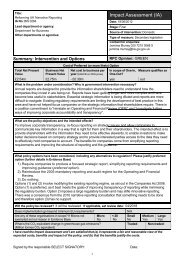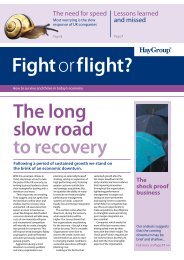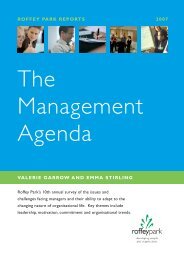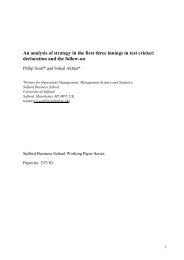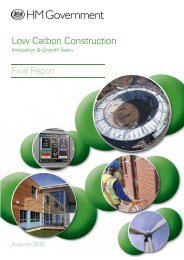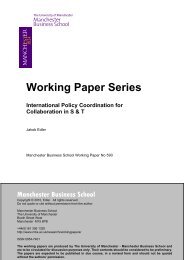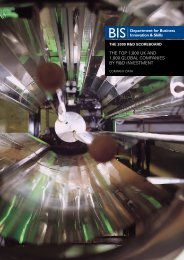Research Paper - Management and Business Studies Portal
Research Paper - Management and Business Studies Portal
Research Paper - Management and Business Studies Portal
Create successful ePaper yourself
Turn your PDF publications into a flip-book with our unique Google optimized e-Paper software.
Annex I Comparison of U.K. <strong>and</strong> U.S. Statutory Recognition SchemesTable I below compares the U.S. <strong>and</strong> U.K. statutory schemes during the period 2000through 2002. Major variations in the U.K. statutory system are shown for each stageof the general process with comparable U.S. procedures described opposite.Table 1: U.K. Statutory Recognition Scheme Compared to U.S. Scheme, By StageU.K. variation, by stageStage 1: Application(1) Before applying for statutoryrecognition, the union must writeemployers seeking a non-statutory,negotiated recognition agreement.(2) If both parties agree, then anindependent public agency, Acas, willconduct an informal ballot or membershipcheck among workers in the proposedbargaining unit.(3) To be accepted for statutoryrecognition, the union must show not onlythat ten (10) percent of the proposedbargaining unit are union members but alsothat a majority of workers support unionrepresentation.(4) If a union withdraws from CACproceedings after the CAC has accepted itsapplication, the union is barred for three(3) years from using the statutoryrecognition procedures for the samebargaining unit.Stage 2: Bargaining UnitDetermination(5) If parties are unable to agree on theappropriate bargaining unit they areencouraged to seek the assistance of Acasto work out their differences voluntarily.(6) If parties cannot agree, the bargainingunit will be imposed by the CAC.Comparable U.S. process(1) None. Traditionally, unions write a“recognition letter” to employers requestingimmediate recognition, but this is not aformal requirement for filing a petition withthe NLRB.(2) None.(3) For the NLRB to order an election, theunion must prove that thirty (30) percent ofthe unit “show an interest” in unionrepresentation.(4) Where a NLRB election has been held,there is a 1-year bar against elections in thesame bargaining unit.(5) None.(6) The NLRB determines the appropriatebargaining unit.Stage 3: Worker Consensus(7) Trade union representatives have aright to have access to workers during theelection period; parties may negotiate aformal access agreement specifying termsor access.(7) Under the NLRA, the employer may notinterfere with the workers’ right to organizecollectively, which gives some rights to solicitworkers; union representatives do not have aright of direct access to workers.17




